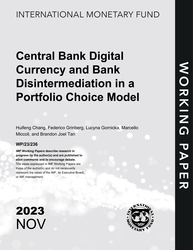
Central Bank Digital Currency and Bank Disintermediation in a Portfolio Choice Model
Central Bank Digital Currency and Bank Disintermediation in a Portfolio Choice Model
READ MORE...
Volume/Issue:
Volume 2023
Issue 236
Publication date: November 2023
ISBN: 9798400259029
$20.00
Add to Cart by clicking price of the language and format you'd like to purchase
Available Languages and Formats
| English |
Prices in red indicate formats that are not yet available but are forthcoming.
Topics covered in this book
This title contains information about the following subjects.
Click on a subject if you would like to see other titles with the same subjects.
Banks and Banking , Finance , Economics- Macroeconomics , Money and Monetary Policy , Economics / General , CBDC , banking disintermediation , financial inclusion , monetary policy , CBDC introduction , bank disintermediation , introduction of a Central Bank Digital Currency , margin loss , lending in the banking sector , Central Bank digital currencies , Bank deposits , Deposit rates , Bank credit
Also of interest
Summary
Would the introduction of a Central Bank Digital Currency (CBDC) lead to lower deposits (disintermediation) and lending in the banking sector? This paper develops a model where households heterogeneous in wealth allocate between an illiquid asset and assets that can be used for payments: bank deposits, cash, and CBDC. CBDC is more efficient as a means of payment and has lower access cost than deposits. Deposits are offered by an imperfectly competitive banking sector which raises deposit interest rates after CBDC introduction to prevent substitution away from deposits to CBDC. We find that there are two opposing margins of impact on the level of aggregate deposits: (1) the intensive margin gain in deposits by richer households increasing their holdings of deposits because of higher interest rates, and (2) the extensive margin loss of deposits among poorer households who switch from deposits to the CBDC. The extensive margin loss in deposits is more likely to dominate (yielding a fall in aggregate deposits) when the mass of poorer households is large and when it is relatively costly to access bank accounts. This tends to be the case in developing and emerging market economies. However, even when the extensive margin loss of deposits dominates and there is disintermediation, the impact on lending is quantitatively small if banks have access to other forms of funding, such as wholesale or central bank financing.
Copyright © 2010 - 2025
Powered by:
AIDC



